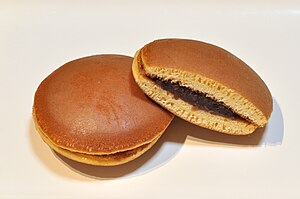Dorayaki as a Symbol of Japanese Daily Life
Dorayaki is a typical Japanese cake that is very well known and popular, not only in Japan but also in various parts of the world. This cake consists of two soft pancakes filled with sweet red bean paste, and is often considered a symbol of everyday Japanese life.
Dorayaki has a long history that links it to Japanese culture. This cake often appears in various Japanese media, including manga, anime, and television programs. Dorayaki is not only a delicious dessert, but also a cultural element that influences the way Japanese people enjoy their everyday Food. On occasions such as celebrations and festivals, dorayaki is often a fun snack choice for many people.
The existence of dorayaki in daily Japanese life illustrates a simple but meaningful eating habit. This cake can be found in various places, from traditional bakeries to modern cafes, and is often brought as lunch or enjoyed while relaxing. Dorayaki are also often given as gifts or souvenirs, adding to their symbolic value in Japanese culture.
Apart from that, dorayaki has become a cultural icon that not only represents deliciousness, but also the warmth and friendliness of the Japanese people. Through its various appearances in the media and its role in everyday life, dorayaki continues to be an alluring symbol that represents the richness of Japanese culture.
With all these aspects, dorayaki is indeed more than just a cake; it is a part of everyday life that reflects the traditions and customs of Japanese society.
Japanese cakes that are favorites of animation characters
Dorayaki, a traditional Japanese cake, has become more than just a delicious snack—it has also earned a special place in the world of Japanese animation. This cake, consisting of two soft pancakes filled with sweet red bean paste, frequently appears in various animated series and manga, making it a favorite among animated characters.
In many anime, dorayaki not only appears as a food enjoyed by characters, but is also often a symbol of warmth and comfort. One of the most famous examples is the character Doraemon, a robot cat from the future who really likes dorayaki. Doraemon’s love for this cake has made dorayaki more widely known, especially outside Japan.
The appearance of dorayaki in anime often depicts simple but enjoyable moments in the characters’ lives. This cake is often a gift, a snack shared between friends, or even as a comfort in difficult situations. This makes dorayaki not only a culinary symbol but also an element that unites and strengthens the relationships between characters in the story.
Dorayaki, with its attractive shape and sweet taste, has captured the hearts of many manga viewers and readers. Its popularity in Japanese animation shows how important this cake is in Japanese culture and how a simple food can be an important part of the narratives and characters we love. In this way, dorayaki is not just a snack—it is part of a cultural heritage brought to life through the world of animation.
Icon Dorayaki: A Sweet Cake that Represents Japanese Culture in Media
Dorayaki is a Japanese sweet pastry that has transcended culinary boundaries and become a cultural icon in various media. Made of two soft pancakes filled with sweet red bean paste, dorayaki is not only known for its delicious taste, but also for its important role in the representation of Japanese culture.
In many Japanese media, dorayaki often appears as a symbol of warmth and comfort. One of the most famous examples is the character Doraemon, a robot cat from the future who really likes dorayaki. The appearance of this cake in the animated series Doraemon not only shows the character’s love for this snack, but also introduces dorayaki to a global audience. This cake is often used as a gift or food enjoyed in simple moments, adding to its appeal as part of everyday life.
Dorayaki is also frequently seen in Japanese manga, films, and television programs, where it symbolizes a rich culinary tradition. This cake becomes a bridge that connects the audience with Japanese culture, depicting values such as friendliness and togetherness.
With its appearance in various media, dorayaki has not only become a favorite snack but also a symbol that represents the warmth of Japanese culture. Through its representation in animation and other media, dorayaki teaches us about the beauty of a simple food and how it can play an important role in culture and everyday life.
Dorayaki as a Souvenir: Its Popularity Among Japanese Tourists
Dorayaki, a traditional Japanese cake consisting of two soft pancakes filled with sweet red bean paste, has become a popular choice as a souvenir among Japanese tourists. This cake is not only known for its delicious taste, but also because it is easy to take home as a practical souvenir.
On their trips to Japan, many tourists are interested in taking home dorayaki as a memento of their visit. These cakes are often neatly packaged and can be found in various gift shops and shopping centers in Japan. Dorayaki is also a popular choice because of its easy packaging and good durability, so it stays fresh even when carried long distances.
Dorayaki is not just about taste; it also represents a touch of authentic Japanese culture. By choosing dorayaki as a souvenir, tourists can take home not only food, but also a part of Japan’s culinary tradition. These cakes are often given as gifts to friends and family, allowing them to experience the delights and culture of Japan even if they cannot visit the country.
The popularity of dorayaki as a souvenir reflects its broad appeal and ability to touch the hearts of many people. As a souvenir, dorayaki not only offers a pleasing taste, but also an authentic cultural experience, making it a highly appreciated choice among tourists who want to take home sweet memories of Japan.
